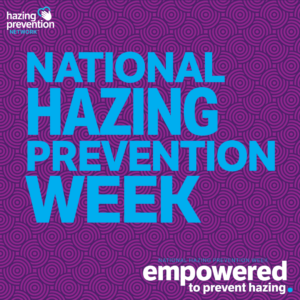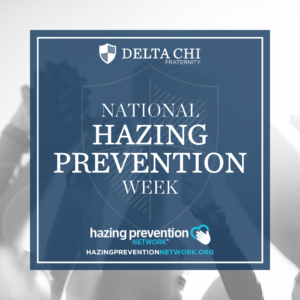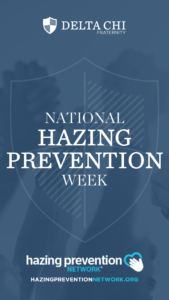 National Hazing Prevention Week (NHPW) is an opportunity for campuses, schools, communities, organizations, and individuals to come together to talk about hazing in their communities, raise awareness about the problem of hazing, educate others about hazing, and promote the prevention of hazing. Held the last week of September each year, the Hazing Prevention Network (HPN) organizes and sponsors this annual week of a renewed focus on the prevention of hazing. HPN is a national nonprofit dedicated to empowering people to prevent hazing. Their goal is to educate people about the dangers of hazing, advocate for change, and engage the community in strategies to prevent hazing. Delta Chi is a proud bronze-level sponsor of the Hazing Prevention Network.
National Hazing Prevention Week (NHPW) is an opportunity for campuses, schools, communities, organizations, and individuals to come together to talk about hazing in their communities, raise awareness about the problem of hazing, educate others about hazing, and promote the prevention of hazing. Held the last week of September each year, the Hazing Prevention Network (HPN) organizes and sponsors this annual week of a renewed focus on the prevention of hazing. HPN is a national nonprofit dedicated to empowering people to prevent hazing. Their goal is to educate people about the dangers of hazing, advocate for change, and engage the community in strategies to prevent hazing. Delta Chi is a proud bronze-level sponsor of the Hazing Prevention Network.
During September 25-29, 2023, NHPW will focus on the theme “Empowered to prevent hazing.” This hazing prevention theme is meant to help educate, advocate, promote, and fundraise. At Delta Chi, we should be “empowered to prevent hazing” throughout the entire year, not just during National Hazing Prevention Week.
What is Hazing?
Delta Chi prohibits hazing in all forms.
No chapter, member, Associate Member, or alumnus shall conduct, participate in, or condone hazing activities. Knowledge of hazing and failure to take timely and appropriate action is condoning hazing. Permission or approval, whether expressed or implied, by a person being hazed is not a defense.
As outlined in the Delta Chi Risk Management Policies, hazing is defined as:
Any action taken, or situation created to cause or reasonably cause mental or physical discomfort or harm, intimidation, harassment, or embarrassment for the purpose of gaining or continuing membership of any kind in the Fraternity. Such activities may include but are not limited to the following: forced or implied consumption of alcohol or drugs, confining individuals to a space for any period of time, subjecting individuals to excessively loud environments to disorient or make uncomfortable, calisthenics as a means of punishment, depriving of sleep or displacing someone from their normal sleep schedule or location, forced or implied sexual activity, lineups of any kind for the purpose of questioning/quizzing or demeaning, threats of any kind including withholding initiation into the Fraternity, wearing of similar attire which separates by membership status, personal servitude or running errands of any kind with or without reimbursement, required carrying of certain items, restriction of communication, and any other activities which are not consistent with academic achievement, fraternal law, ritual or policy or the regulations and policies of the educational institution or applicable state law.
SEPTEMBER 25-29, 2023: WEBINARS
Click the following title of the upcoming webinars to register or attend:
Monday, September 25, 2023
2:00 PM ET – Quality Hazing Prevention: A Panel of Experts Provide Insights
Tuesday, September 26, 2023
2:00 PM ET – Lost in Translation: Cultural Competency in Hazing Prevention Efforts – with Rasheed Ali Cromwell
4:30 PM ET – Understanding and Impacting Athletic Team Culture as it Relates to Hazing
Wednesday, September 27, 2023
12:00 PM ET – Disrupting the Orchestration: Getting to Facts in a Hazing Investigation
2:00 PM ET – A Framework for Practice: Using Situational Strength to Challenge Hazing Cultures
7:30 PM ET – Never Leave Anyone Behind: iamstonefoltz Foundation Live Stream
8:00 PM ET – Delta Chi Hazing Prevention Webinar
Thursday, September 28, 2023
11:00 AM ET – Making or Breaking the Team: Hazing in Sports
2:00 PM ET – National Gordie Day: Alcohol & Hazing
Additional Recorded Webinar(s):
–Hazing: How “Innocent Fun” Gets Out of Tune Fast, by Archie Messersmith-Bunting, Archie Cares
–Empowered to prevent hazing – with Dr. Lori Hart, The Catalyst Agency, and Todd Shelton, HPN
-Prevention IS Your Job: A Fraternity/Sorority Partner Discussion – with Holmes Murphy
Stories & Essays:
-Lianne Kowiak’s Story
The Facts
- According to a 2017 research study conducted by YouGov, a public opinion research company, as many as 22 percent of Americans indicate that they have been hazed.
- Younger adults (ages 18-34) indicate experiencing more hazing and older adults (ages 55+) less.
- 47% of students come to college having experienced hazing.
- 55% of college students involved in clubs, teams, and organizations experience hazing.
- 98% of all high school students belonged to at least one group.
- 48% of students who belonged to groups experienced hazing.
- 43% reported being humiliated and 30% took part in potentially illegal activity.
- More than 250,000 athletes experienced some form of hazing to join a college athletic team with 20% of those subjected to dangerous and potentially illegal activity.
A quick internet search will reveal that hazing occurs in almost every kind of group from athletes to cheerleading, band, performing arts, etc. Hoover and Pollard point out that:
- Male and female students reported high levels of hazing.
- Students with lower grade point averages are at higher risk of being hazed.
- High school students in nearly every kind of group experienced hazing, including 24% of students in church groups.
- College students report similar experiences with hazing occurring even among honor society member and members of academic clubs.
Resources
Selected Academic Studies
- Jeckell, Aaron & Copenhaver, Elizabeth & Diamond, Alex. (2020). Hazing and Bullying in Athletic Culture.
- Kowalski, Robin & Foster, Mackenzie & Scarborough, Molly & Bourque, Leah & Wells, Stephen & Graham, Riley & Bednar, Hailey & Franchi, Madeleine & Nash, Sarah & Crawford, Kelsey. (2020). Hazing, Bullying, and Moral Disengagement. International Journal of Bullying Prevention.
Information & resources adapted from the Hazing Prevention Network. For more information visit hazingpreventionnetwork.org.





